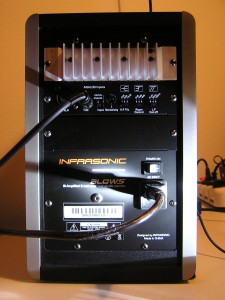There is an interesting difference between the computer music presenter and a live act. While the centered tape operator has perfect conditions for creating the best possible sound, for presenting a finished work in the most brilliant way (which might occasionally even include virtuoso mixing desk science rather than static adjustment to match room acoustics), the live act has to fight with situations which are far from perfect and at the same time is expected to be more lively. Given these conditions, it is no wonder that generally rough and direct live sets are more enjoyable, while the attempt to reproduce complex studio works on a stage seem more likely to fail.
A rough sounding performance simply seems to match so much more the visual information we get when watching a guy behind a laptop. Even if we have no clue about their work, there is a vague idea of how much complexity a single person can handle. The more the actions result in an effect like a screaming lead guitar, the more we feel that it is live. If we experience more detail and perfection we most likely will suspect we are listening to pre-prepared music. And most of the time we are right with this assumption.
From “Live Performance in the Age of Supercomputing” by Robert Henke

